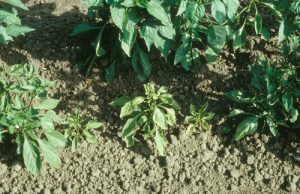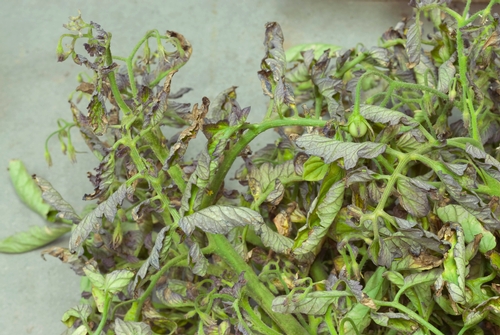Program-wide Notice

Tomato infected with curly top viruses: Leaves can be thickened, deformed, yellowed, and rolled upwards. Symptomatic tomato leaves often develop purple veins.
(Image courtesy UC-ANR)
- Beet leafhopper counts remained very low throughout the fall. Counts typically increase as fallow fields are disked and grazed, however, BLH populations did not increase and were still low and scattered by the end of October.
- There were a total of seventy-one (71) host plant samples collected and sent for virus analysis in August. Only nine (9) of them were positive for curly top virus.
- There was one (1) beet leafhopper sample collected and sent for virus analysis in August. It was positive for curly top virus.
- There were a total of fifty-eight (58) host plant samples collected and sent for virus analysis in September. Seven (7) were positive for curly top virus.
- There were a total of fifty (50) beet leafhopper samples collected and sent for virus analysis in September. Twenty (20) were positive for curly top virus.
- There were a total of eight (8) host plants samples collected and sent for virus analysis in October. Seven (7) were negative for curly top virus. One sample was not tested.
- There were fourteen (14) BLH samples collected and sent for virus analysis in October. Only one (1) was positive for curly top virus.
- Due to very low BLH counts, a fall spray campaign was not conducted. Some areas in Fresno County and Kings County that had “hot spots” were treated by ground rig application.
Fresno County

Tomato infected with curly top viruses: If infected early, plants can be severely stunted.
(Image courtesy UC-ANR)
- Program personnel monitored the areas mapped as “potential fall treatment” for BLH populations and fall host plants in Firebaugh, Mendota, Huron, Five Points, Three Rocks, Cantua Creek, and Coalinga. Additional acreage was removed from potential treatment maps due to grazing and disking. Remaining host plants consisted of Russian thistle, Bassia, and saltbush and were viable.
- BLH counts were low in September and October, with an average of 0-2 BLH per sweep. Nymphs were observed in a few locations. Thrips and non-target leafhoppers were abundant in many of the fields surveyed.
- There were a few “hot spot” areas in Cantua Creek, Three Rocks, and Mendota that were treated by ground rig application toward the end of October. A total of 160 gallons of mixed malathion were used. Russian thistle and Bassia were the predominant host plants and were stressed and drying at time of treatment. BLH counts in this “hot spot” were 5-10 per sweep.
- A rain event occurred at the end of October, however, winter host plants have not emerged at this time.
Kern County
- Program personnel monitored the areas mapped as “potential fall treatment” for BLH populations and fall host plants. Some disking/grazing occurred toward the end of September.
- BLH counts remained very low in September and October. Counts were 0-2 BLH per sweep. Some nymphs were observed during surveys.
- Russian thistle and Bassia declined in viability and became unfavorable for BLH by the end of October.
- Two rain events occurred in October, however, winter host plants have not emerged at this time.
- Treatment was not conducted in Kern County this fall.
Kings County
- Program personnel monitored the areas mapped as “potential fall treatment” for BLH populations and fall host plants.
- Personnel monitored the previously mapped fields for BLH and host plants.
- BLH counts remained low in September and October, with an average of 0-2 BLH per sweep.
- An area of about 8,000 acres of fallow ground off of Utica Ave and east of Interstate 5 consisted of mostly Russian thistle and some Bassia. BLH counts were 1-4 adults per sweep. This area was also being monitored as a possible location to conduct organic trials, however, the counts were inconsistent and only a few “hot spots” were observed. By the end of October, counts in this same area had slightly increased to 3-8 adult BLH per sweep. The “hot spots” had counts of 25+ adults and 25+ nymphs per sweep. Due to overall low BLH counts, this area wasn’t treated aerially, but the “hot spots” were treated by ground rig application toward the end of October. Host plants in the area were stressed and drying. About 1,000 acres of the area had also been mowed and plowed by the end of October. A total of 240 gallons of mixed malathion were used in ground rig application.
Merced County

Pepper infected with curly top viruses: If infected early, plants can be severely stunted.
(Image courtesy UC-ANR)
- BLH population surveys, host plant vegetation surveys, and fallow field surveys were conducted.
- BLH counts remained very low with an average of 0-1 adult BLH per sweep in September and October.
- Personnel will continue to monitor BLH populations and collect both host plant and BLH samples for virus analysis.
San Joaquin County

Pepper infected with curly top viruses: Leaves can be thickened, deformed, and rolled upwards.
(Image courtesy UC-ANR)
- BLH population surveys, host plant vegetation surveys, and fallow field surveys were conducted.
- BLH counts remained very low with an average of 0-1 adult BLH per sweep.
- Personnel will continue to monitor BLH populations and collect both host plant and BLH samples for virus analysis.
Stanislaus County
- BLH population surveys, host plant vegetation surveys, and fallow field surveys were conducted.
- BLH counts remained very low with an average of 0-1 adult BLH per sweep.
- Personnel will continue to monitor BLH populations and collect both host plant and BLH samples for virus analysis.










